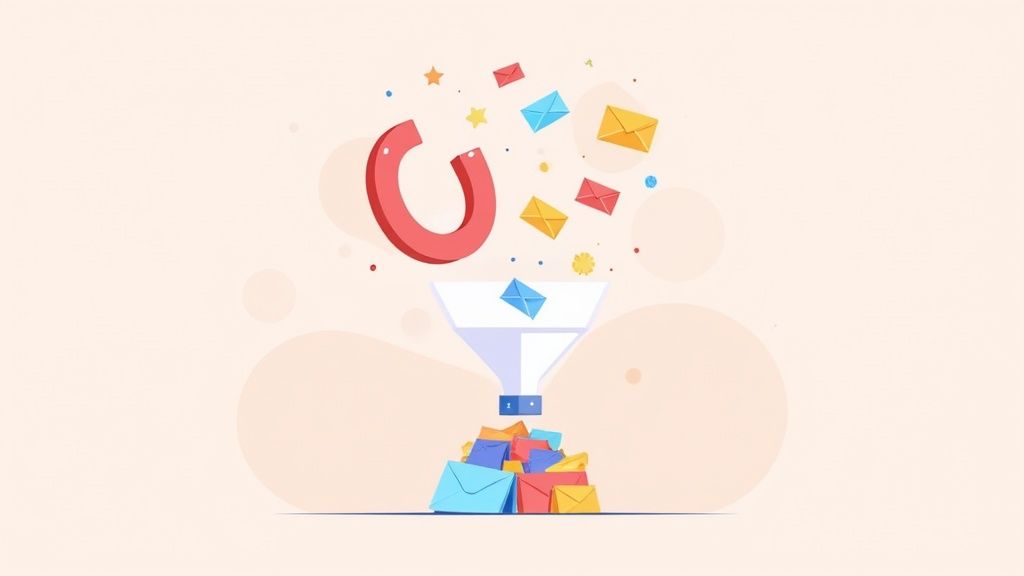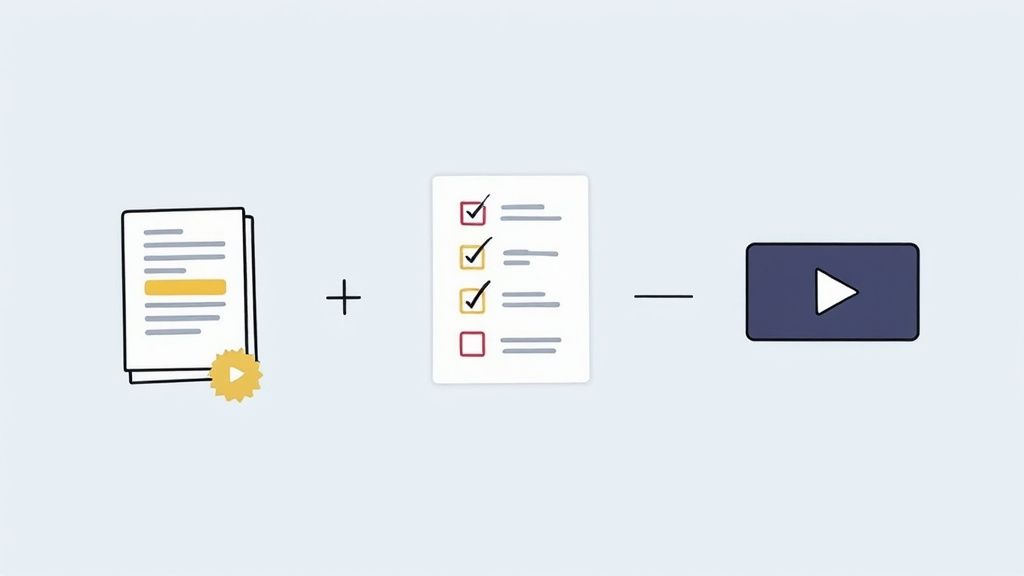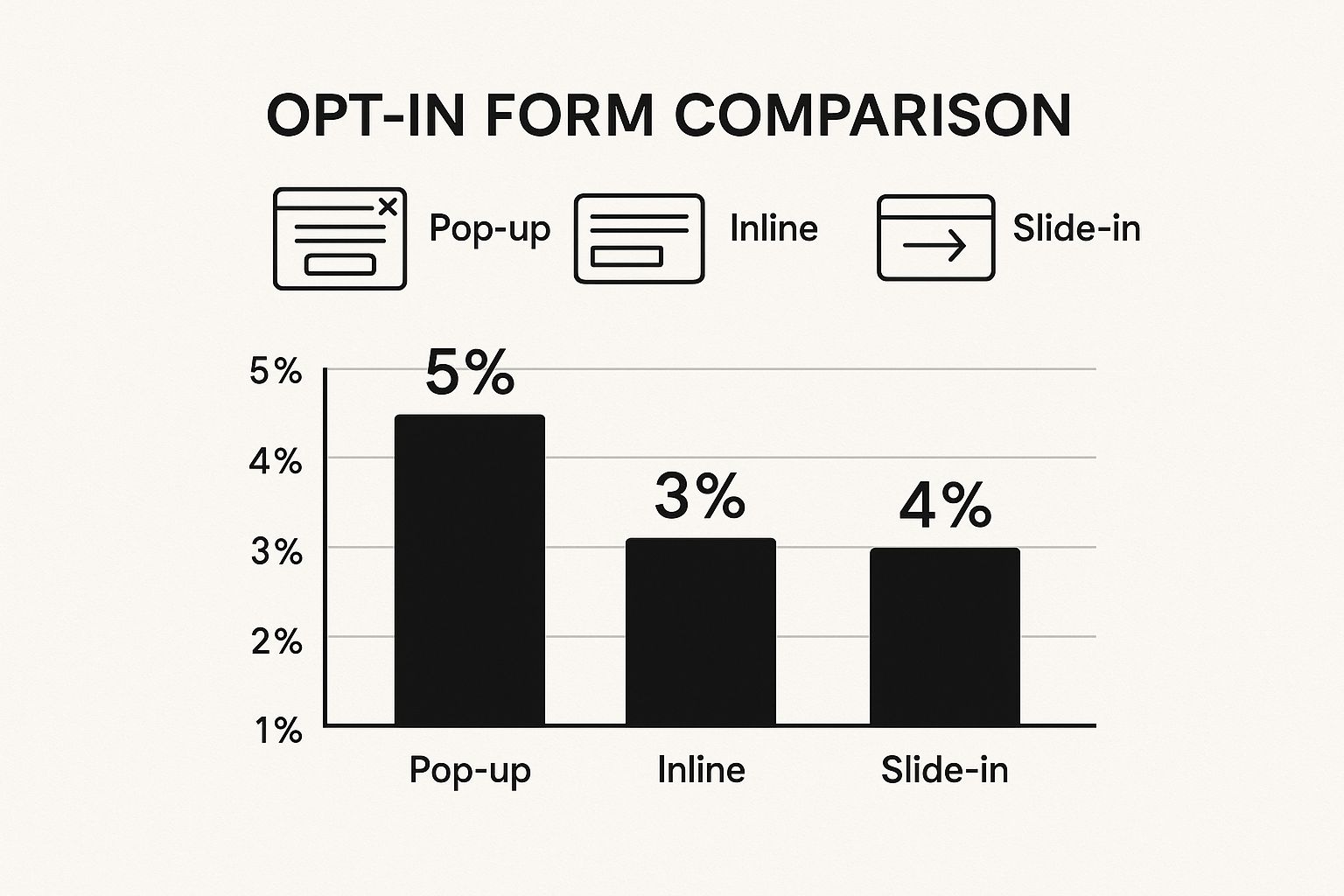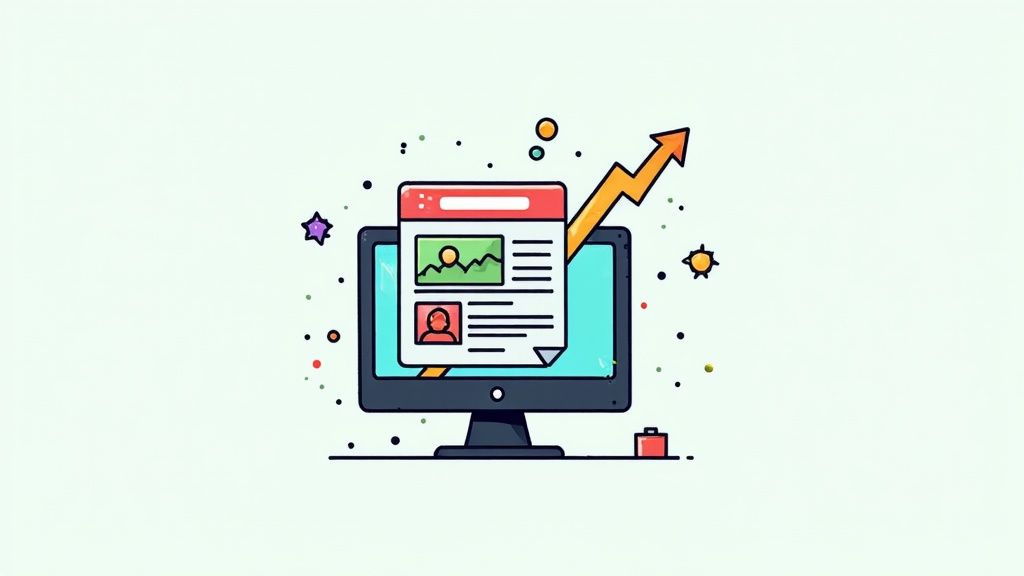How to Build Email List from Scratch: Proven Strategies

Building an email list really boils down to a simple value exchange: you need to offer something so good that people are willing to trade their email address for it.
The whole game is creating an irresistible offer—what we call a lead magnet—and putting it right in the path of your ideal audience. When you nail this exchange, you start turning casual website visitors into a loyal community.
Why an Email List Is Your Most Valuable Asset

Sure, a big social media following looks impressive, but you're ultimately building on rented land. Algorithms can change overnight, platforms fall out of favor, and your account could get shut down without any warning. Poof. The audience you worked so hard to build is gone.
Your email list, on the other hand, is a digital asset that you completely own and control. Think of it as your insurance policy in a digital world that’s always in flux. It lets you sidestep those unpredictable algorithms and talk directly to your most engaged fans and customers.
Building a Community You Own
An email list is so much more than a database of contacts; it's a community you are actively building from the ground up. Every single subscriber has raised their hand and said, "Yes, I want to hear from you." That permission-based relationship is incredibly powerful.
To really tap into this, you need to get the core strategies right. If you want a deep dive, check out this a comprehensive guide on how to build an email list which covers the fundamentals.
This direct channel gives you a few massive advantages:
- Direct Communication: You can send your message straight to someone's inbox. No platform filter, no algorithm hiding your content. They will see it.
- Deeper Relationships: Email gives you the space for more personal, long-form communication than a tweet or a story ever could. This is how you build real trust and rapport over time.
- Predictable Revenue: By nurturing your list, you create a reliable channel for promotions, product launches, and sales. This leads to much more stable, predictable income.
Owning your email list means you own the relationship with your audience. You're not just a temporary guest on a social platform; you're building a lasting asset that grows in value as your business does.
And this channel is only getting more important. The global email user base is projected to hit 4.6 billion people by 2025. On top of that, 60% of consumers actually prefer email for getting communications from brands. The opportunity here is massive.
Choosing Your List Building Toolkit

Before you can even think about capturing that first email, you need to have the right gear. This isn't about snagging the most expensive software on the market, but about building a smart setup that actually fits your goals. The absolute foundation of any email list strategy is your Email Service Provider (ESP)—this is the platform that will house your contacts and send all your emails.
Trying to pick an ESP can feel like a mammoth task simply because there are so many choices. The trick is to match the platform to what you actually do.
For example, a content creator or blogger might feel right at home with a tool like ConvertKit. It's built for simple sequences and lets you tag subscribers based on the content they're engaging with, which is a game-changer for creators.
On the other hand, a small business laser-focused on sales will likely need the more robust automation you get from a platform like ActiveCampaign. This opens the door to more complex workflows, like sending a targeted email series to someone who abandons their cart versus someone who just downloaded a free guide. To really get a handle on this, it's worth exploring the basics of marketing workflow automation to see how these systems can work for you.
Selecting the Right ESP for You
Don't let analysis paralysis stop you before you start. The best ESP is the one you’ll actually use. My advice? Think about your immediate needs and what your budget looks like for the next year.
Here’s a quick breakdown to help you get started:
- For Beginners & Creators: Platforms like Mailchimp or ConvertKit are your best friends. They have super user-friendly interfaces, great templates, and are designed to get you up and running with simple automations fast.
- For Growing Businesses: Take a hard look at ActiveCampaign or Drip. These powerhouses offer advanced segmentation, CRM features, and sophisticated automation rules that can grow right alongside your customer base.
Your ESP should grow with you. Starting on a free plan is a smart move, but make sure the platform has the advanced features you'll need later on. Trust me, migrating thousands of subscribers down the road is a headache you want to avoid.
Designing Your Conversion Points
Okay, you've got your ESP. Now, where are you actually going to collect these emails? This is where landing pages and opt-in forms come into play. A landing page is a single, standalone web page created for one purpose and one purpose only: to get a visitor to sign up.
A high-converting landing page isn’t some dark magic; it’s just a combination of proven elements firing on all cylinders. The headline has to grab attention and promise a real benefit. The body copy needs to clearly spell out what the person gets for signing up—focus on the outcome, not just the features.
And finally, social proof is your secret weapon. Adding a simple testimonial or showing your subscriber count can build instant trust and kill that last-minute hesitation. In the end, a simple, clear, and focused page always wins.
Creating Lead Magnets People Actually Want
Let's be honest: a generic "subscribe to our newsletter" button is the digital equivalent of a limp handshake. It's forgettable and uninspiring. If you want to build a truly engaged email list, you have to give people a reason to sign up—a compelling, irresistible offer that solves a real problem for them right now.
This is where the magic of a great lead magnet comes in.
Think of your lead magnet as the first promise you make to a potential customer. It's not just a freebie; it's a quick win that showcases your expertise and gives them a taste of the value you provide.
Get Inside Your Audience's Head
The best lead magnets start with empathy. You need to know your audience inside and out. What are they struggling with? What’s that one nagging problem that keeps them up at night? What task do they dread because it takes way too long?
Your lead magnet needs to be the direct solution to one of those specific problems. For example, if you're a social media consultant, a broad "social media guide" will get lost in the noise. But a hyper-specific "7-Day Instagram Reel Hook Cheatsheet"? Now that’s something someone can use immediately.
A great lead magnet doesn't just offer information; it offers a small transformation. It takes someone from a state of frustration to a moment of clarity and progress.
This is where sharp copywriting is essential. The way you describe your lead magnet needs to scream "benefit" and "relief." If you're new to this, our guide on copywriting for beginners is a great place to build those foundational skills.
Choosing the Right Lead Magnet for Your Audience
To help you decide which format best suits your audience and your business, I've put together a quick comparison table. Think about who you're trying to attract and how much effort you can realistically put in.
| Lead Magnet Type | Best For | Effort to Create | Example |
|---|---|---|---|
| Checklist | Breaking down complex tasks into simple, actionable steps. | Low | A wedding photographer's "Complete Wedding Day Shot List." |
| Template | Saving your audience time and mental energy. | Low-Medium | A financial advisor's "Plug-and-Play Monthly Budget Template." |
| Mini-Guide/Ebook | Providing in-depth knowledge on a very specific topic. | Medium-High | A SaaS company's "Beginner's Guide to Reducing Customer Churn." |
| Webinar/Video | Establishing authority and building a personal connection. | High | A fitness coach's webinar on "5 Common Kettlebell Mistakes." |
Choosing the right format is half the battle. The other half is making sure your audience sees it at just the right moment.
Crafting a High-Value Offer
Once you've identified a pain point and chosen a format, it’s all about delivery. Some of the most powerful list-building techniques combine a valuable freebie with a perfectly timed prompt.
For instance, an exit-intent popup—the kind that appears just as someone is about to leave your site—can convert up to 3% of abandoning visitors into subscribers. That's a huge win! The key is making the offer directly relevant to what they were just reading.

As you can see from the data, pop-ups tend to have the highest conversion rates, but don't take that as gospel. You have to test what works for your audience and website. An inline form might work better on a blog post, while a slide-in might feel less intrusive on your homepage.
Ultimately, your goal is to make the exchange feel less like a transaction and more like a genuinely helpful gift. When you get that right, people won't just subscribe; they'll be excited to hear from you.
Where to Place Your Opt-In Forms for Maximum Conversions

So, you've created an amazing lead magnet. That's a huge step, but it won't do much good if nobody ever sees the offer. This is where strategic placement comes in. It's the difference between a list that grows on autopilot and a signup box that just gathers digital dust.
The whole game is about being present and helpful, not pushy and annoying. You want to weave your offers into the user's journey so naturally they feel like a helpful next step. Think of your website as prime real estate; you need to put your forms in high-traffic areas where they’ll catch the eye without wrecking the experience.
High-Visibility Static Placements
Some spots on your website are simply too valuable to ignore. These static placements are your workhorses, always visible to a huge chunk of your traffic and acting as reliable anchors for your list-building.
- Homepage Hero Section: This is your digital handshake. Placing a clear, concise call-to-action right below your main headline is a golden opportunity to capture interest from the moment someone lands on your site.
- Website Footer: The footer is the universal catch-all. Visitors who scroll all the way down are often engaged, making it a perfect, low-pressure spot to invite them to stay in touch.
- Blog Sidebar: While some people develop "sidebar blindness," it’s still a conventional spot users look for when they want to subscribe to a newsletter, especially on content-heavy sites.
- Within Blog Posts: An inline form tucked midway through a relevant article can be incredibly effective. You're catching readers right when they're most engaged with your expertise and looking for more.
Don't just set it and forget it. The real magic happens when you use a mix of these placements. Someone might scroll right past the hero section but notice the form in your footer. Multiple, non-intrusive touchpoints give you the best shot at conversion.
Mastering Smart Popups and Overlays
Popups get a bad rap, but hear me out. When used thoughtfully, they can be your single most powerful conversion tool. Modern popups aren't the jarring, full-screen ads of the past. They’re intelligent tools that can appear based on specific user behavior.
This is where you can get really dialed in with your timing and targeting.
- Exit-Intent Popups: These forms appear just as a user’s cursor moves toward the browser's back or close button. It's your last chance—a final, helpful offer to capture their email before they disappear for good.
- Scroll-Triggered Forms: You can set a form to appear only after a visitor has scrolled 50-70% down a page. This is a great signal they're actually reading and engaged, making them far more likely to be interested in what you have to offer.
- Welcome Mats: This is a full-screen overlay that greets a user the moment they land on your site. Use this one sparingly. The offer needs to be exceptionally valuable to justify such a direct interruption.
If you're looking to diversify your lead capture methods beyond traditional forms, check out this fantastic guide to lead generation chatbots. They offer a more interactive way to collect information and can really boost engagement.
By strategically mapping out these opt-in points across your entire website, you create a seamless system that works around the clock to build your most valuable asset: your email list.
Driving the Right Traffic to Your Offers
So you've built a brilliant lead magnet and have your opt-in forms perfectly placed. That's a fantastic start. But without a steady stream of the right people seeing your offers, your list growth is going to hit a wall.
It’s time to stop just hoping for visitors and start strategically attracting your ideal subscribers. The goal isn't just more traffic; it's better traffic. You need to connect with people who are already out there looking for the exact solutions you provide.
Building Your Organic Traffic Engine
If you're after sustainable, long-term growth, you need to build a solid organic foundation. These are the strategies that take more effort upfront but pay you back for months, sometimes even years. Think of it as planting an orchard instead of just buying fruit from the store.
One of the most powerful ways to do this is by creating blog posts that are optimized for search engines. This isn't about stuffing keywords everywhere. It's about answering the very specific questions your audience is typing into Google. When you create content that genuinely solves a problem, you attract high-intent visitors who are primed to subscribe for more.
For example, if you’re a business consultant, a post titled "5 Common Mistakes New Entrepreneurs Make" is going to attract exactly the right crowd. By embedding your "Business Launch Checklist" lead magnet right inside that article, you create a seamless path from curious reader to new subscriber.
Your blog content should act as the perfect appetizer for your lead magnet. It provides immediate value and proves you have the expertise, making the decision to sign up for the main course an easy one.
This is a critical part of the puzzle. If you want to go deeper on attracting these kinds of potential customers, our guide on how to generate leads offers a more expansive look at this crucial step.
Leveraging Social Platforms Authentically
Social media can be another goldmine for traffic, but you have to play by the rules of each platform. Simply blasting out links to your signup form won't cut it. The real magic happens when you promote your lead magnets in a way that feels native and valuable.
Here’s how that might look in practice:
- Pinterest: This platform is basically a visual search engine, making it perfect for things like checklists, templates, and guides. A single, well-designed pin promoting a blog post with a content upgrade can drive consistent traffic for months on end. People on Pinterest are actively looking for solutions.
- LinkedIn: If you're targeting a professional audience, share a key insight or a surprising statistic from your lead magnet as a simple text post. Then, in your bio or the first comment, invite people to get the full guide.
- Instagram: Use Stories to run a poll related to the problem your lead magnet solves. You can then send a direct link to the signup page to everyone who engages, which makes the offer feel a bit more exclusive and personal.
Scaling Growth with Paid Advertising
Once you've got your organic channels bringing in a consistent flow of subscribers and you've proven your offer converts, you might be ready to pour some fuel on the fire with paid ads. Paid traffic gives you immediate feedback and lets you get incredibly precise with your targeting.
Platforms like Facebook, Instagram, and Google Ads allow you to run hyper-targeted campaigns. You can show your ads to users based on their interests, demographics, and online behavior, ensuring your lead magnet gets in front of the people most likely to want it.
The key is to start small. Test your ad creative, your copy, and your landing page with a manageable budget before you even think about scaling up your spending.
Got Questions About Building Your List?
As you dive into the world of email marketing, a few questions always seem to surface. It’s completely normal. Let’s get you some clear, straightforward answers so you can move forward with confidence.
How Long Does It Take to Get 1,000 Subscribers?
There’s no magic number here, but with a solid lead magnet and consistent traffic, hitting your first 1,000 subscribers can realistically take anywhere from 3 to 6 months. But honestly, the timeline isn't the most important metric.
The real focus should be on the quality of the people you're attracting. I'd take 100 die-hard fans who open every email over 1,000 subscribers who couldn't care less about what I send. Quality always trumps quantity.
What’s a Good Opt-In Conversion Rate?
If you’re seeing a site-wide opt-in rate somewhere between 1% and 5%, you're in a great spot. That's a healthy benchmark for most websites.
Of course, context is everything. A hyper-specific offer, like a checklist offered as a content upgrade within a super-relevant blog post, can easily hit conversion rates of 10% or even higher. I've seen it happen time and again.
Don’t get discouraged if your conversion rates are below 1%. See it as a data point, not a failure. It’s simply a signal telling you it's time to experiment—try a new lead magnet, tweak your headline, or test a different spot for your sign-up form.
Should I Ever Buy an Email List?
Let me make this crystal clear: no. Never, ever, ever buy an email list. I know it seems like a tempting shortcut when you're starting from zero, but it’s a strategy that will absolutely torpedo your efforts.
Think about it—these people never asked to hear from you. Here’s what happens next:
- Your engagement will be abysmal. They don’t know who you are, so why would they open your emails?
- You'll get a flood of spam complaints. This is the fastest way to get your email service provider to shut down your account.
- You'll destroy your sender reputation. When you’re marked as spam, email clients like Gmail and Outlook learn to send your messages straight to the junk folder, even for people who do want to hear from you.
Building your list the right way—organically—is the only path to creating an audience that actually knows, likes, and trusts you.
How Often Should I Email New Subscribers?
When you’re just starting, consistency beats frequency every single time. A great rhythm to get into is sending one high-value, genuinely useful email per week.
This keeps you on their radar without clogging up their inbox. As you go, watch your open and click-through rates like a hawk; those numbers will tell you what’s landing and what’s not. And hey, there's no shame in just asking your subscribers what they want to see from you. They'll appreciate it.
Turn your expert content into visually stunning carousels that capture attention and grow your audience. With Lumeo, you can create high-impact visual assets in minutes, not hours. Start creating for free today!